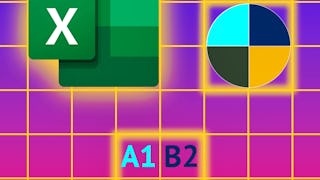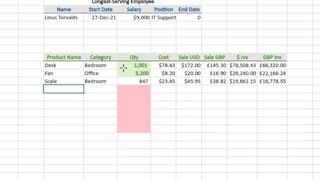"Everyday Excel, Part 1" is aimed at learners who are seeking to learn Excel from the ground up. No experience with Excel is necessary. While this course is meant for beginners of Excel, advanced users will undoubtedly pick up new skills and tools.

4 days left: Get a Black Friday boost with $160 off 10,000+ programs. Save now.


Everyday Excel, Part 1
This course is part of Everyday Excel Specialization

Instructor: Charlie Nuttelman
293,074 already enrolled
Included with
(3,641 reviews)
Recommended experience
What you'll learn
Navigating Excel, editing the worksheet (including inserting/deleting cells, columns, and rows), and cell formatting.
Expression entry and common Excel formulas (including logical functions, text functions, and financial functions).
Data management (sorting, filtering, consolidating, removing duplicates, data validation, and one-way lookups).
Data visualization (scatter plots, column charts, pie charts, Slicers, Sparklines, and Pivot Tables).
Skills you'll gain
Details to know

Add to your LinkedIn profile
11 assignments
See how employees at top companies are mastering in-demand skills

Build your subject-matter expertise
- Learn new concepts from industry experts
- Gain a foundational understanding of a subject or tool
- Develop job-relevant skills with hands-on projects
- Earn a shareable career certificate

There are 5 modules in this course
In Week 1, you will learn basic worksheet navigation, how to open and save Excel files, and all about worksheets and workbooks. You will learn the difference between cells, columns, and rows in Excel, as well as cell references. You will learn how to move around the worksheet effectively using shortcut key combinations, and you will learn how to edit the worksheet. You will also learn how to format cells, conditionally format cells, and how to change between number, text, date, currency, and other cell formatting options. There will be particular emphasis on relative vs. absolute cell addressing modes and you will learn how to name cells and cell ranges. You will be introduced to basic macro recording using VBA and you will learn how to set personal preferences in Excel. Week 1 will conclude with a required quiz and an on-computer, in-application assignment. When you successfully complete Assignment 1, you will be given a "completion code", which you can input into the Assignment 1 submission quiz to earn credit for the assignment. The Week 2 material will be released when you have successfully passed Quiz 1 and Assignment 1. Good luck!
What's included
21 videos11 readings3 assignments2 discussion prompts
In Week 2 you will learn about how to properly write Excel syntax. You will learn the order of operations, how to input mathematical formulas into Excel, and how to troubleshoot when things don't go as expected. You will be introduced to just a few of the thousands of built in functions in Excel. The functions that you will learn about in this module relate to summing, counting, averaging, how to round numbers and calculate remainders, random number generation, and combinations and permutations. Week 2 concludes with a quiz and an on-computer, in-application assignment. Upon successful completion of these items, the Week 3 material will be unlocked. Good luck and have fun!
What's included
12 videos2 readings2 assignments1 discussion prompt
In Week 3, you will learn more advanced functions in Excel. These include logical functions (IF, AND, OR) and advanced logical functions (SUMIF, COUNTIF, AVERAGEIF). You will learn how to effectively use Auto Fill and Fill Series but then I explain how to use text functions, which overcome some of the limitations of the Auto Fill feature. You will be introduced to Excel's financial functions (many more financial functions will be covered in Part 2 of the course), and you will learn how to use array formulas in Excel. Finally, I show how you can create your own user-defined function in VBA. Week 3 concludes with a quiz and on-computer, in-application assignment. When completed successfully, the Week 4 material will be released. Good luck!
What's included
12 videos2 readings2 assignments1 discussion prompt
Week 4 really gets at the heart of why Excel is so great for managing data. You will learn how to apply a filter, how to create an Excel Table, and how to validate data (for example, by only allowing items in a drop-down list). You will learn how to sort data, how to clean up data prior to using, how to remove duplicates in your data, and how to consolidate data from multiple sources. Finally you will learn how to use one-way lookup functions in Excel (VLOOKUP and the INDEX/MATCH combination). Quiz 4 and the on-computer, in-application Assignment 4 will test your understanding of the material in Week 4. Once you've completed these assessments, the Week 5 material will be unlocked. Good luck and have fun!
What's included
15 videos2 readings2 assignments1 discussion prompt
Week 5 is all about data visualization. You will learn the differences between and how to use scatter plots, column charts, and pie charts. You will be introduced to Pivot Tables, Slicers, and Sparklines, which all represent different and exciting ways to visualize your data. I will show you how to share data (embed vs. linking) with Word and PowerPoint as well as how to print your worksheets and how to convert them to .pdf documents. Like the other modules, Week 5 concludes with a quiz and an on-computer, in-application assignment. When you've completed those assessments, you will earn the Course Certificate! Good luck!
What's included
13 videos2 readings2 assignments1 discussion prompt
Earn a career certificate
Add this credential to your LinkedIn profile, resume, or CV. Share it on social media and in your performance review.
Instructor

Offered by
Explore more from Design and Product
 Status: Free Trial
Status: Free TrialUniversity of Colorado Boulder
 Status: Free Trial
Status: Free TrialUniversity of Colorado Boulder
 Status: Preview
Status: PreviewKnowledge Accelerators
Why people choose Coursera for their career




Learner reviews
3,641 reviews
- 5 stars
83.28%
- 4 stars
11.80%
- 3 stars
1.70%
- 2 stars
0.60%
- 1 star
2.60%
Showing 3 of 3641
Reviewed on Feb 28, 2021
I learned quite a bit on how to operate excel and learned quite a few formulas with I have integrated into some of the spreadsheet we use at work. This has help create a accurate information.
Reviewed on May 18, 2020
Very much basic course and the instructor described Everything very nicely..Its a must for the beginne.. Had to work hard to go through the course and finally came out to be successful
Reviewed on Jun 30, 2022
This course is excellent and is best for beginners who wish to get familiar with excel and learn its vast features that enhance your problem solving ability and also saves significant amount of time.

Open new doors with Coursera Plus
Unlimited access to 10,000+ world-class courses, hands-on projects, and job-ready certificate programs - all included in your subscription
Advance your career with an online degree
Earn a degree from world-class universities - 100% online
Join over 3,400 global companies that choose Coursera for Business
Upskill your employees to excel in the digital economy
Frequently asked questions
To access the course materials, assignments and to earn a Certificate, you will need to purchase the Certificate experience when you enroll in a course. You can try a Free Trial instead, or apply for Financial Aid. The course may offer 'Full Course, No Certificate' instead. This option lets you see all course materials, submit required assessments, and get a final grade. This also means that you will not be able to purchase a Certificate experience.
When you enroll in the course, you get access to all of the courses in the Specialization, and you earn a certificate when you complete the work. Your electronic Certificate will be added to your Accomplishments page - from there, you can print your Certificate or add it to your LinkedIn profile.
Yes. In select learning programs, you can apply for financial aid or a scholarship if you can’t afford the enrollment fee. If fin aid or scholarship is available for your learning program selection, you’ll find a link to apply on the description page.
More questions
Financial aid available,


